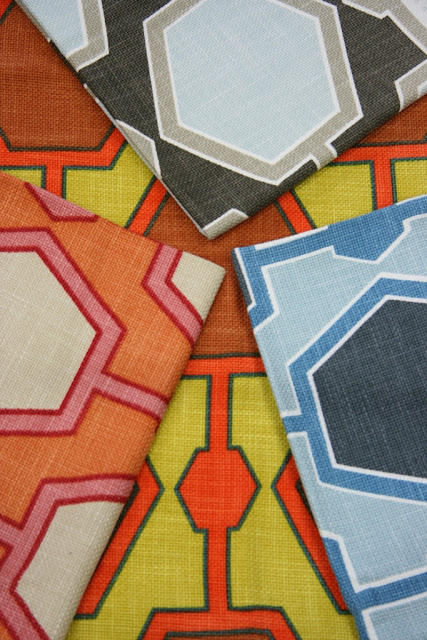Monday, March 27, 2017
The Joy of Flowers
Spring is here, the flowers and trees are in bloom (and have been for quite some time here in the South), and that annual layer of yellow pollen covers everything, my dog's feet included. Irritants aside, Spring is the time of year when flowers, in all their vibrant glory, seem to especially command our attention, both in their natural habitats and indoors, where they add bright notes to our homes' interiors.
Today, many of us limit our houses to a vase or two of peonies, a potted orange tree, or even a ubiquitous fiddle-leaf fig, but back in the early part of last century, the enthusiasm for indoor plants and floral bouquets was unabashed, so much so that plants were often incorporated into interiors in inspired and splashy ways. Take these 1933 House & Garden images, for example. It was not uncommon for flowers to be the main decoration of a room- and this didn't only occur in expected spots like sunrooms. Below, you'll find a living room where a floral chintz banquette was crowned by a generous number of potted plants and flowers, lacing a large bay window. In another, a Chippendale-style bird cage and window boxes- so cheerful and gay, to use a popular phrase of the day- stand prominently in front of a window, which gazed out onto a rather stifling view of neighboring high-rises. Even a dining room was made to feel like an indoor garden, this time with an imagined design of planters and trellis, built to flank a window.
In fact, flowers were such an important part of indoor decor that many homes had shelves built inside of windows, where plants had the luxury of basking in the sunshine, blurring the line between indoors and out. And while I think these indoor window shelves look a little dated, I appreciate the way in which they allowed plants to command a room's attention.
As Dorothy Draper once said, "It isn't enough just to love flowers- you do them an injustice if you don't make the best possible use of their beauty"- a sentiment obviously shared by the owners of the houses seen here. But beware of the predilection to decorate with a profusion of flowers, at least, according to the late decorator Michael Greer: "Too many flowers in a room imply the presence of a corpse and should be avoided unless there is one, and even then too many flowers can distress anyone of delicate taste."
Monday, March 13, 2017
New Offerings from Jim Thompson and No. 9 Thompson
I recently spent a pleasant morning at the Jim Thompson showroom at ADAC, perusing the new collections from both Jim Thompson and No. 9 Thompson. Both collections featured such vibrant colors and pattern that I was aching to recover my furniture in anticipation of summer.
First up are two collections from Jim Thompson: Leo de Janeiro and Negresco, an outdoor fabric collection. Ou Baholyodhin, Jim Thompson's Creative Director for Home Furnishings, conceived Leo de Janeiro as a marriage of Chinese culture ("Leo" representing a Chinese lion) with the exotic, exuberant energy of Carnival in Rio de Janeiro. One of my favorite introductions is Leo de Janeiro, the namesake of the new collection, which features a whimsical Chinese lion that is up to mischief. This particular fabric strikes me as the type that, no matter how long it's in use as curtains or upholstery, you'll continue to cherish it until the fabric is in tatters. Other favorites of mine include Ming Ming (especially the version in black), Heliconia Dreamin', a sumptuously embroidered fabric, and Cala, which is a fresh and colorful update of a traditional silk moire. Equally as tempting is Belize, a bamboo print from the Negresco outdoor collection. It looks like a fabric that might have been used in the home of Betsy Bloomingdale or at Sunnylands, the Annenbergs' Palm Springs estate.
Leo de Janeiro
Menagerie
Ming Ming
Marquise
Heliconia Dreamin'
Pomare
Cala
Harrow
Jim Thompson Negresco Collection of Outdoor Fabric:
Patron
Belize
No. 9 Thompson
For his new No. 9 Thompson collections, Colourfield and All Aboard (an outdoor range), designer Richard Smith cites inspiration ranging from painter Lucio Fontana's slash series and Matisse cut-outs to 1960's Pop Art and African textiles. The mood of the collection is upbeat, which is an outlook that we could all use these days. Prints such as Breton, Matelot, and In a Twist strike a nautical note, while Zig Zag seems like the kind of print that would have appealed to Albert Hadley. The collection is fun, not too serious, and just right for the warmer weather ahead. Of the selection I'm showing below, all are outdoor fabrics with the exception of In a Twist, Decoupage, and Areso.
For both the Jim Thompson and No. 9 Thompson collections, I'm only showing you a sampling of fabrics. To see the full range, visit the Jim Thompson website or your local designer showroom.
Breton
Matelot
Zee Urchin
Diamond Life
In a Twist
All Aboard
Decoupage
Areso
All images courtesy of Jim Thompson
Tuesday, March 07, 2017
Making a Hash of Things
Isn't odd how certain things that have never before been on your radar suddenly push their way into your consciousness thanks to their repetitive appearances in the most random places? Take, for example, canned corned beef. Strange that I came across mentions of this tinned meat product twice last week. The first time was reading E.F. Benson's Miss Mapp (which, by the way, you should read, if you haven't already); in one particularly humorous scene, Miss Mapp, the title character, is discovered to be hoarding food in anticipation of a coal strike. What gave her away? A can of corned beef, which became dislodged from a shelf of a hidden closet, only to come crashing to the floor when one of Miss Mapp's guests accidentally opens the secret door. OK, so maybe you need to have read the book to find this funny.
My second run-in with canned corned beef came a few days later, when my copy of Annabel's was delivered. The book, now out-of-print, chronicles the history and the legend of this much-loved London nightclub, which, sadly, I have never had the opportunity to visit. I was prompted to hunt down a copy of the book upon learning of Annabel's impending move to a new location close-by. Anyway, while flipping through the book, I found Mark Birley's recipe for Corned Beef Hash, which is to be sumptuously served with a poached egg on top. You'll find the recipe below.
I've eaten neither canned corned beef nor corned beef hash before, so their tastiness (or lack thereof) is a mystery to me. Perhaps I'll take a stab at the recipe someday soon. And to make up for this hash of a post, I'm also including photos of Annabel's interiors, taken from the book. In surroundings such as these, how could food- even canned corned beef- taste anything but delicious?
Mark Birley's Corned Beef Hash
1 medium baking potato, about 200g
1/2 small onion, finely chopped
1 tbsp. extra virgin olive oil, plus extra for frying
340g can corned beef
1 tbsp. chopped fresh parsley
2 tsp Worcestershire sauce
1 tsp English mustard
Sea salt and freshly ground white pepper
Steam the potato for about 20 minutes until just tender. When cool, peel and cut into 5mm dice. Tip into a big bowl.
Saute the onion gently in 1 tbsp. oil for about 5 minutes until softened. Add this to the diced potato.
Cut the corned beef into 5mm dice. Mix into the potatoes with the parsley, Worcestershire sauce, mustard, and seasoning to taste.
Heat a thin film of oil in a large frying pan. Cook the hash for 3-5 minutes, stirring once or twice, until lightly browned and crispy in parts. Serve immediately. Serves 2.
Friday, March 03, 2017
The Maria Theresa L. Virata Collection at Christie's
A highlight of Christie's upcoming Asian Art Week is The Maria Theresa L. Virata Collection of Asian Art: A Family Legacy sale, which will take place in New York on March 16. The Virata family collection, assembled over the last fifty years under the guidance of the family's late matriarch, Maria Theresa, is notable for its range of Asian art and ceramics. But perhaps the most significant part of the collection are the singular examples of Chinese furniture, something which makes this auction particularly noteworthy.
For Maria Theresa Virata, or Bebe, as she was also known, her passion for collecting Asian art developed alongside her interest in archaeology and the history of her native Philippines. Aiding Virata in her collecting was the late Robert Hatfield Ellsworth, the highly-regarded Asian art dealer. Ellsworth's Fifth Avenue apartment was unique in that he displayed his Asian art alongside English furniture and European decorative arts. It seems the apartment must have made an impression on Virata, who similarly lived with all three in her house in the Philippines.
Below, you'll see photos of the Virata family house, which is spectacular in its elegance and reserve. But equally as compelling are the sale's eighty-plus lots, which include a rare pair of seventeenth-century Huanghuali armchairs (see below) as well as Chinese porcelain. It should be noted that the sale's proceeds will benefit three charitable organizations: Child Protection Network; ICanServeFoundation, Inc.; and Cribs Foundation, Inc.
For more information on the sale, please visit the Christie's website.
QI BAISHI (1864-1957)
Sunrise over Water
Hanging scroll, ink and color on paper
51 ¼ x 20 ⅝ in. (130.2 x 52.3 cm.)
Inscribed and signed, with two seals of the artist
Dedicated to Jinqing
Estimate: $500,000-700,000
THE ‘ECKE CHAIRS’
A VERY RARE PAIR OF HUANGHUALI ARMCHAIRS, NANGUANMAOYI
17TH CENTURY
39 in. (99 cm.) high; 24 1/2 in. (62.2 cm.) Wide; 20 1/4 in. (51.4 cm.) deep (each) (2)
Estimate: USD 600,000-800,000
A FLAMBÉ-GLAZED VASE
QIANLONG SIX-CHARACTER INCISED SEAL MARK AND OF THE PERIOD (1736-1795)
8 3/4 in. (22.2 cm.) high
Estimate: $30,000-50,000
AN IMPORTANT ZITAN LUOHAN BED, LUOHANCHUANG
18TH CENTURY
29 1/4 in. (74.3 cm.) high; 87 in. (221 cm.) wide; 51 in. (129.5 cm) deep
Estimate: USD 2,000,000-3,000,000
Photo credits: Interior shots, @Visko Hatfield, 2017; all other images, Christie's Images, Ltd., 2017
Subscribe to:
Posts (Atom)























































